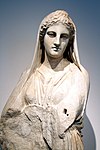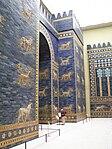The Vorderasiatisches Museum (German: [ˈfɔʁdɐ.ʔaˌzi̯atɪʃəs muˈzeːʊm], Near East Museum) is an archaeological museum in Berlin. It is in the basement of the south wing of the Pergamon Museum and has one of the world's largest collections of Southwest Asian art. 14 halls distributed across 2,000 square meters of exhibition surface display southwest Asian culture spanning six millennia. The exhibits cover a period from the 6th millennium BCE into the time of the Muslim conquests. They originate particularly from today's states of Iraq, Syria and Turkey, with singular finds also from other areas. Starting with the Neolithic finds, the emphasis of the collection is of finds from Sumer, Babylonia and Assyria, as well as northern Syria and eastern Anatolia.
Excavations in historically important cities like Uruk, Shuruppak, Assur, Hattusha, Tell el Amarna, Tell Halaf (Guzana), Sam'al, Toprakkale and Babylon built the foundation of the museum's collection. Further acquisitions came from Nimrud, Nineveh, Susa and Persepolis. The museum shows finds from the cultures of Sumer, Akkad, Babylonia, Assyria, the Hittites and the Aramaeans. These finds often found their way to Berlin via the German Oriental Society. In 1899, the Middle East Department at the royal museums was created. In 1929, they were provisionally accommodated in the Bode Museum and the Pergamon Museum, where they have been accessible to the public since 1930. During the Second World War, there were hardly any war-related losses. The mobile exhibits, which were taken as art spoilage to the Soviet Union, were returned to East Germany in 1958. The collection had already opened again as the Vorderasiatisches Museum in 1953.
Notable pieces of the collection are the Ishtar Gate and Procession Way of Babylon, remainders of the ancient city of Babylon, parts of the Eanna temple and Karaindash's temple to Inanna in Uruk. The museum also has an important number of Southwest Asian stamp and cylinder seals, as well as cuneiform texts. It has more than 200 of the Amarna letters and the larger ("Meissner") fragment (VAT 4105) of the Sippar tablet from the Epic of Gilgamesh, which includes Siduri's advice, unlike later editions of the epic.
At present (2019) Barbara Helwing is the director of the museum, following Markus Hilgert (2014-2018). Previous directors were Beate Salje, Walter Andrae, Gerhard Rudolf Meyer, Liane Jakob-Rost and Evelyn Klengel Brandt, among others.










